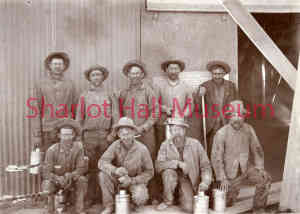Miners Posed
details
Unknown Unknown 1600.0119.0001.jpg M - 119 B&W 1600-0119-0001 m119pa Print 5x7 Historic Photographs 1890s Reproduction requires permission. Digital images property of SHM Library & ArchivesDescription
Posed outside a mine in Yavapai County, Arizona Territory, c.1890.
“The deeper they went, the hotter it got.” (Time-Life Books, 1976, The Old West, The Miners, p. 77)
The life of hard rock miners was not easy. They lived in crude shacks and boarding houses with thin plank partitions, they worked in and many time collapsed from heat exhaustion in mines that went 2,000 feet underground and they froze in outdoor privies. Occupational hazards included mine collapses, drilling mishaps, pneumonia, “miner’s consumption,” and rheumatism. Falls were a common cause of death. Some miners were injured in explosions or electrocuted. Others fell off ladders, slipped on rocks, inhaled silica dust, or suffered from mercury, lead or arsenic poisoning. Many got sick from drinking dirty water and living too close together.
Simple candles and lamps provided the only light in a mine’s underground drifts and winzes. They burned 24 hours a day. Temperatures surpassed 100 degrees Fahrenheit at depths of 1500’ and beyond. Miners wore minimal attire, breechcloths or long underwear bottoms only. Narrow-brimmed hats or felt skullcaps and rudimentary shoes were the extent of their “safety equipment.”
At such depths, the rock they drilled was customarily too hot-to-the-touch. Scalding steam and/or hot water often flowed from crevices or drilled holes in the walls of a mine’s interior. Some relief was provided by blowers staged on the surface of a mine, it forced cooler air into the depths of a mine thru a network of pipes. Workmen were provided with copious amounts of water and sometimes ice that they could chew on. Because of the heat, men could only work about one half hour at a time or face collapse from heat exhaustion.
Worn down by the nature of their solitary work and darkened environment, they often sought solace in drink. Heavy drinking was the curse of copper and all other mining. Whiskey was often called “Miner’s milk;” some miners put away a quart of whiskey a day.
Many miners hired out to work in a mine only for the short-term. These men were called "floaters." They would work just long enough to make money to take care of their immediate needs. Many would then quit that employer and celebrate for a few days in the closest town or saloon. As a result, they would work only about eight days each month, a term coined a "miner's month." They would then seek work at an adjoining property or move on to another mining area.
Purchase
To purchase this image please click on the NOTIFY US button and we will contact you with details
The process for online purchase of usage rights to this digital image is under development. To order this image, CLICK HERE to send an email request for details. Refer to the ‘Usage Terms & Conditions’ page for specific information. A signed “Permission for Use” contract must be completed and returned. Written permission from Sharlot Hall Museum is required to publish, display, or reproduce in any form whatsoever, including all types of electronic media including, but not limited to online sources, websites, Facebook Twitter, or eBooks. Digital files of images, text, sound or audio/visual recordings, or moving images remain the property of Sharlot Hall Museum, and may not be copied, modified, redistributed, resold nor deposited with another institution. Sharlot Hall Museum reserves the right to refuse reproduction of any of its materials, and to impose such conditions as it may deem appropriate. For certain scenarios, the price for personal usage of the digital content is minimal; CLICK HERE to download the specific form for personal usage. For additional information, contact the Museum Library & Archives at 928-445-3122 ext. 14 or email: orderdesk@sharlot.org.




